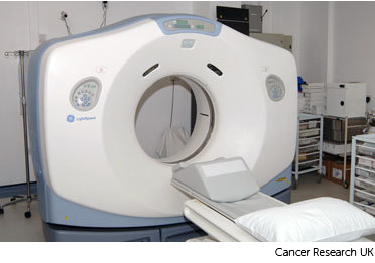Planning radiotherapy for prostate cancer
The radiotherapy team plan your external radiotherapy before you start treatment. This means working out the dose of radiotherapy you need and exactly where you need it.
Your planning appointment takes from 15 minutes to 2 hours.
You usually have a planning CT scan in the radiotherapy department.
The scan shows the cancer and the area around it. You might have other types of scans or x-rays to help your treatment team plan your radiotherapy. The plan they create is just for you.
Before you have your planning scan, your nurse or radiographer ask you to sign a consent form.
Your planning CT scan
Before the scan, you might need to empty your bowels and fill your bladder. This is because having an empty bowel and a comfortably full bladder can help to reduce the movement of the prostate and lower the dose of radiation to nearby healthy tissues. To do this your radiographers might give you an  and tell you to drink a certain amount of water.
and tell you to drink a certain amount of water.
Your radiographers will tell you whether you need to do this.
The scan
You lie on the scanner couch. You usually have to remove your trousers before you get on the couch. As your radiographers need to see the treatment area, they usually ask you to lower your underwear. But they keep you covered up.

The radiographers put some markers that show up on the scan on your skin.
Once you are in position the radiographers move the couch up and through the scanner. You need to lie very still. Your radiographers leave the room and the scan starts. It takes about 5 minutes. You won't feel anything. The radiographers watch from the room next door.
Metal markers
Your doctor might put small metal markers called fiducial markers into your prostate gland.
To place the markers, your doctor inserts a needle into the prostate. They do this while you are having an ultrasound scan during an outpatient appointment. Once the tip of the needle is in the right place your doctor releases the metal marker. The markers are about 2 to 3 millimetres.
Fiducial markers are one way of making sure that your treatment is accurate, as they act as a marker for your prostate. Your radiographers take images (x-rays or scans) before each of your treatments and match your fiducials. This should then mean that your prostate is in the same position for treatment as it was during your planning scan.
Ink and tattoo marks
The radiographers make pin point sized tattoo marks on your skin. They use these marks to line you up into the same position every day. The tattoos make sure they treat exactly the same area for all of your treatments. They may also draw marks around the tattoos with a permanent ink pen, so that they are clear to see when the lights are low.

The radiotherapy staff tell you how to look after the markings. The pen marks might start to rub off in time, but the tattoos won’t. Tell your radiographer if that happens. Don't try to redraw them yourself.
After your planning session
It can take a few days or up to 2 to 3 weeks before you start treatment. During this time the physicists and your radiotherapy doctor create your radiotherapy plan. They make sure that the area of the cancer will receive a high dose and surrounding areas receive a low dose.



